[English] 日本語
 Yorodumi
Yorodumi- PDB-5a9k: Structural basis for DNA strand separation by a hexameric replica... -
+ Open data
Open data
- Basic information
Basic information
| Entry | Database: PDB / ID: 5a9k | ||||||
|---|---|---|---|---|---|---|---|
| Title | Structural basis for DNA strand separation by a hexameric replicative helicase | ||||||
 Components Components | REPLICATION PROTEIN E1 DNA replication DNA replication | ||||||
 Keywords Keywords |  HYDROLASE / DNA REPLICATION FORK HYDROLASE / DNA REPLICATION FORK | ||||||
| Function / homology |  Function and homology information Function and homology information DNA helicase activity / DNA helicase activity /  DNA helicase / DNA helicase /  DNA replication / host cell nucleus / DNA replication / host cell nucleus /  ATP hydrolysis activity / ATP hydrolysis activity /  DNA binding / DNA binding /  ATP binding ATP bindingSimilarity search - Function | ||||||
| Biological species |   BOVINE PAPILLOMAVIRUS BOVINE PAPILLOMAVIRUS | ||||||
| Method |  ELECTRON MICROSCOPY / ELECTRON MICROSCOPY /  single particle reconstruction / single particle reconstruction /  negative staining / Resolution: 19 Å negative staining / Resolution: 19 Å | ||||||
 Authors Authors | Chaban, Y. / Stead, J.A. / Ryzhenkova, K. / Whelan, F. / Lamber, K. / Antson, F. / Sanders, C.M. / Orlova, E.V. | ||||||
 Citation Citation |  Journal: Nucleic Acids Res / Year: 2015 Journal: Nucleic Acids Res / Year: 2015Title: Structural basis for DNA strand separation by a hexameric replicative helicase. Authors: Yuriy Chaban / Jonathan A Stead / Ksenia Ryzhenkova / Fiona Whelan / Ekaterina P Lamber / Alfred Antson / Cyril M Sanders / Elena V Orlova /  Abstract: Hexameric helicases are processive DNA unwinding machines but how they engage with a replication fork during unwinding is unknown. Using electron microscopy and single particle analysis we determined ...Hexameric helicases are processive DNA unwinding machines but how they engage with a replication fork during unwinding is unknown. Using electron microscopy and single particle analysis we determined structures of the intact hexameric helicase E1 from papillomavirus and two complexes of E1 bound to a DNA replication fork end-labelled with protein tags. By labelling a DNA replication fork with streptavidin (dsDNA end) and Fab (5' ssDNA) we located the positions of these labels on the helicase surface, showing that at least 10 bp of dsDNA enter the E1 helicase via a side tunnel. In the currently accepted 'steric exclusion' model for dsDNA unwinding, the active 3' ssDNA strand is pulled through a central tunnel of the helicase motor domain as the dsDNA strands are wedged apart outside the protein assembly. Our structural observations together with nuclease footprinting assays indicate otherwise: strand separation is taking place inside E1 in a chamber above the helicase domain and the 5' passive ssDNA strands exits the assembly through a separate tunnel opposite to the dsDNA entry point. Our data therefore suggest an alternative to the current general model for DNA unwinding by hexameric helicases. | ||||||
| History |
|
- Structure visualization
Structure visualization
| Movie |
 Movie viewer Movie viewer |
|---|---|
| Structure viewer | Molecule:  Molmil Molmil Jmol/JSmol Jmol/JSmol |
- Downloads & links
Downloads & links
- Download
Download
| PDBx/mmCIF format |  5a9k.cif.gz 5a9k.cif.gz | 317.1 KB | Display |  PDBx/mmCIF format PDBx/mmCIF format |
|---|---|---|---|---|
| PDB format |  pdb5a9k.ent.gz pdb5a9k.ent.gz | 265.4 KB | Display |  PDB format PDB format |
| PDBx/mmJSON format |  5a9k.json.gz 5a9k.json.gz | Tree view |  PDBx/mmJSON format PDBx/mmJSON format | |
| Others |  Other downloads Other downloads |
-Validation report
| Arichive directory |  https://data.pdbj.org/pub/pdb/validation_reports/a9/5a9k https://data.pdbj.org/pub/pdb/validation_reports/a9/5a9k ftp://data.pdbj.org/pub/pdb/validation_reports/a9/5a9k ftp://data.pdbj.org/pub/pdb/validation_reports/a9/5a9k | HTTPS FTP |
|---|
-Related structure data
| Related structure data |  3087MC  3088C  3089C  3090C  3091C  5a9l  5a9m  5a9n  5a9o M: map data used to model this data C: citing same article ( |
|---|---|
| Similar structure data |
- Links
Links
- Assembly
Assembly
| Deposited unit | 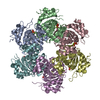
|
|---|---|
| 1 |
|
- Components
Components
| #1: Protein |  DNA replication / 3.6.4.12 / ATP-DEPENDENT HELICASE E1 DNA replication / 3.6.4.12 / ATP-DEPENDENT HELICASE E1Mass: 34645.016 Da / Num. of mol.: 6 / Fragment: HELICASE DOMAIN, RESIDUES 301-605 Source method: isolated from a genetically manipulated source Source: (gene. exp.)   BOVINE PAPILLOMAVIRUS / Organ: NUCLEUS BOVINE PAPILLOMAVIRUS / Organ: NUCLEUS Cell nucleus / Plasmid: PET11C / Production host: Cell nucleus / Plasmid: PET11C / Production host:   ESCHERICHIA COLI (E. coli) / Strain (production host): BL21(DE3) / References: UniProt: P03116, ESCHERICHIA COLI (E. coli) / Strain (production host): BL21(DE3) / References: UniProt: P03116,  DNA helicase DNA helicase#2: Chemical | ChemComp-PO4 /  Phosphate Phosphate#3: Chemical | #4: Water | ChemComp-HOH / |  Water Water |
|---|
-Experimental details
-Experiment
| Experiment | Method:  ELECTRON MICROSCOPY ELECTRON MICROSCOPY |
|---|---|
| EM experiment | Aggregation state: PARTICLE / 3D reconstruction method:  single particle reconstruction single particle reconstruction |
- Sample preparation
Sample preparation
| Component | Name: HELICASE DOMAIN OF THE FULL-LENGTH E1 HELICASE FROM BOVINE PAPILLOMAVIRUS Type: VIRUS |
|---|---|
| Buffer solution | Name: 10 MM TRIS-CL PH 8.0, 225 MM NACL, 2 MM DTT, 0.1 MM PMSF, 0.1 MM EDTA pH: 8 Details: 10 MM TRIS-CL PH 8.0, 225 MM NACL, 2 MM DTT, 0.1 MM PMSF, 0.1 MM EDTA |
| Specimen | Conc.: 3 mg/ml / Embedding applied: NO / Shadowing applied: NO / Staining applied : YES / Vitrification applied : YES / Vitrification applied : NO : NO |
| EM staining | Type: NEGATIVE / Material: uranyl acetate |
| Specimen support | Details: CARBON |
- Electron microscopy imaging
Electron microscopy imaging
| Experimental equipment |  Model: Tecnai F20 / Image courtesy: FEI Company |
|---|---|
| Microscopy | Model: FEI TECNAI F20 / Date: Feb 18, 2010 |
| Electron gun | Electron source : :  FIELD EMISSION GUN / Accelerating voltage: 200 kV / Illumination mode: FLOOD BEAM FIELD EMISSION GUN / Accelerating voltage: 200 kV / Illumination mode: FLOOD BEAM |
| Electron lens | Mode: BRIGHT FIELD Bright-field microscopy / Nominal magnification: 62000 X / Calibrated magnification: 67000 X / Nominal defocus max: 1500 nm / Nominal defocus min: 500 nm / Cs Bright-field microscopy / Nominal magnification: 62000 X / Calibrated magnification: 67000 X / Nominal defocus max: 1500 nm / Nominal defocus min: 500 nm / Cs : 2.1 mm : 2.1 mm |
| Specimen holder | Temperature: 293 K |
| Image recording | Electron dose: 20 e/Å2 / Film or detector model: GATAN ULTRASCAN 4000 (4k x 4k) |
| Image scans | Num. digital images: 30 |
| Radiation wavelength | Relative weight: 1 |
- Processing
Processing
| EM software |
| ||||||||||||||||||||
|---|---|---|---|---|---|---|---|---|---|---|---|---|---|---|---|---|---|---|---|---|---|
CTF correction | Details: FRAMES | ||||||||||||||||||||
| Symmetry | Point symmetry : C6 (6 fold cyclic : C6 (6 fold cyclic ) ) | ||||||||||||||||||||
3D reconstruction | Method: FILTERED BACK PROJECTION / Resolution: 19 Å / Num. of particles: 8265 / Actual pixel size: 1.6 Å Magnification calibration: CROSS- -CORRELATION DENSITIES WITHIN SPHERICAL SHELL Details: SUBMISSION BASED ON EXPERIMENTAL DATA FROM EMDB EMD-3087. (DEPOSITION ID: 13536). Symmetry type: POINT | ||||||||||||||||||||
| Atomic model building | Protocol: OTHER / Space: REAL / Target criteria: Cross-correlation coefficient Details: METHOD--LOCAL CORRELATION REFINEMENT PROTOCOL--X-RAY | ||||||||||||||||||||
| Atomic model building | PDB-ID: 2V9P | ||||||||||||||||||||
| Refinement | Highest resolution: 19 Å | ||||||||||||||||||||
| Refinement step | Cycle: LAST / Highest resolution: 19 Å
|
 Movie
Movie Controller
Controller


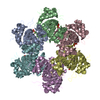
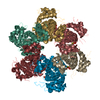
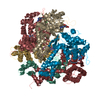
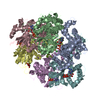

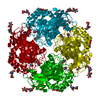


 PDBj
PDBj







